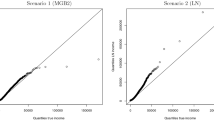Abstract
Over the last decade there has been growing demand for estimates of population characteristics at small area level. Unfortunately, cost constraints in the design of sample surveys lead to small sample sizes within these areas and as a result direct estimation, using only the survey data, is inappropriate since it yields estimates with unacceptable levels of precision. Small area models are designed to tackle the small sample size problem. The most popular class of models for small area estimation is random effects models that include random area effects to account for between area variations. However, such models also depend on strong distributional assumptions, require a formal specification of the random part of the model and do not easily allow for outlier robust inference. An alternative approach to small area estimation that is based on the use of M-quantile models was recently proposed by Chambers and Tzavidis (Biometrika 93(2):255–268, 2006) and Tzavidis and Chambers (Robust prediction of small area means and distributions. Working paper, 2007). Unlike traditional random effects models, M-quantile models do not depend on strong distributional assumption and automatically provide outlier robust inference. In this paper we illustrate for the first time how M-quantile models can be practically employed for deriving small area estimates of poverty and inequality. The methodology we propose improves the traditional poverty mapping methods in the following ways: (a) it enables the estimation of the distribution function of the study variable within the small area of interest both under an M-quantile and a random effects model, (b) it provides analytical, instead of empirical, estimation of the mean squared error of the M-quantile small area mean estimates and (c) it employs a robust to outliers estimation method. The methodology is applied to data from the 2002 Living Standards Measurement Survey (LSMS) in Albania for estimating (a) district level estimates of the incidence of poverty in Albania, (b) district level inequality measures and (c) the distribution function of household per-capita consumption expenditure in each district. Small area estimates of poverty and inequality show that the poorest Albanian districts are in the mountainous regions (north and north east) with the wealthiest districts, which are also linked with high levels of inequality, in the coastal (south west) and southern part of country. We discuss the practical advantages of our methodology and note the consistency of our results with results from previous studies. We further demonstrate the usefulness of the M-quantile estimation framework through design-based simulations based on two realistic survey data sets containing small area information and show that the M-quantile approach may be preferable when the aim is to estimate the small area distribution function.
Similar content being viewed by others
References
Battese GE, Harter RM and Fuller WA (1988). An error-components model for prediction of county op areas using survey and satellite data. J Am Stat Assoc 83(401): 28–36
Betti G (2003). Poverty and inequality mapping in Albania: final report. World Bank and INSTAT (mimeo), Washington DC and Tirana
Bigman D, Dercon S, Guillaume D and Lambotte M (2000). Community targeting for poverty reduction in Burkina Faso. World Bank Econ Rev 14(1): 167–93
Breckling J and Chambers R (1988). M-quantiles. Biometrika 75(4): 761–71
Chambers R and Dunstan R (1986). Estimating distribution functions from survey data. Biometrika 73(3): 597–604
Chambers R, Dorfman AH (2003) Transformed variables in survey sampling. S3RI Methodology Working Papers, M03/21, Southampton Statistical Sciences Research Institute, University of Southampton, UK
Chambers R and Tzavidis N (2006). M-quantile models for small area estimation. Biometrika 93(2): 255–68
Chandra H and Chambers R (2005). Comparing EBLUP and C-EBLUP for small area estimation. Stat Transit 7(3): 637–48
Elbers C, Lanjouw J and Lanjouw P (2003). Mio-level estimation of poverty and inequality. Econometrica 71(1): 355–64
Fay RE and Herriot RA (1979). Estimates of income for small places: an application of James-Stein procedures to census data. J Am Stat Assoc 74(366): 269–77
Foster J, Greer J and Thorbecke E (1984). A class of decomposable poverty measures. Econometrica 52(3): 761–66
Rao JNK (2003). Small area estimation. Wiley, New York
Royall RM and Cumberland WG (1978). Variance estimation in finite population sampling. J Am Stat Assoc 73(362): 351–58
Tzavidis N, Chambers R (2007) Robust prediction of small area means and distributions. Working paper (available upon request)
World Bank (2003) Albania poverty assessment. World Bank Report No. 26213-AL, Washington DC
Author information
Authors and Affiliations
Corresponding author
Rights and permissions
About this article
Cite this article
Tzavidis, N., Salvati, N., Pratesi, M. et al. M-quantile models with application to poverty mapping. Stat Meth Appl 17, 393–411 (2008). https://doi.org/10.1007/s10260-007-0070-8
Accepted:
Published:
Issue Date:
DOI: https://doi.org/10.1007/s10260-007-0070-8




